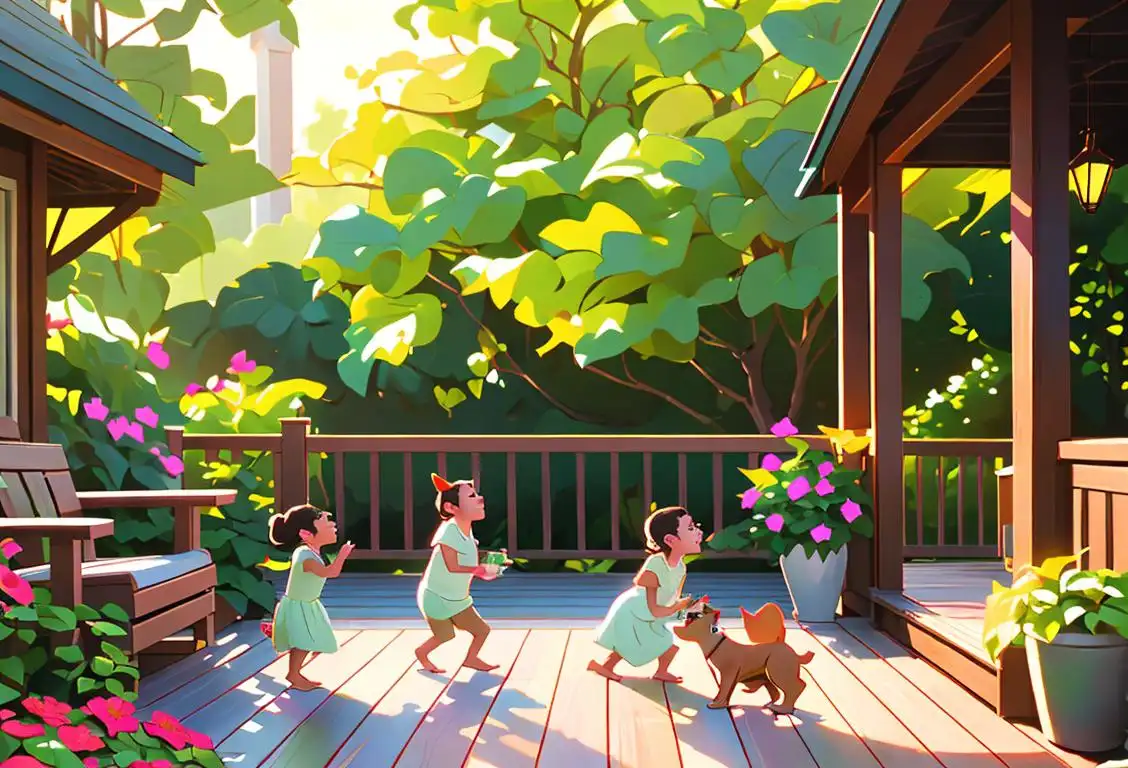National Hot Tub Day

Welcome to National Hot Tub Day, the one day of the year where we celebrate the joy of relaxation, bubbles, and warm water! Whether you have your own hot tub or you're dreaming of soaking in one, join us in honoring this day dedicated to total relaxation.
When is Hot Tub Day?
It's national hot tub day on the 28th March.
The Origins of National Hot Tub Day
Did you know that hot tubs have been around for thousands of years? The ancient Greeks and Romans enjoyed the therapeutic benefits of warm water, and hot tubs were even a part of their social gatherings. Fast forward to the modern era, and hot tubs have become a popular addition to many homes and resorts.
National Hot Tub Day was created as a way to raise awareness about the benefits of hot tub ownership and encourage people to take some time to unwind and relax. It's the perfect excuse to grab your loved ones, put on your swimsuits, and indulge in some quality hot tub time.
How to Celebrate National Hot Tub Day
There are so many ways to celebrate National Hot Tub Day, whether you have your own hot tub or not. If you're lucky enough to have a hot tub in your backyard, invite your friends and family over for a hot tub party. Make sure to have some snacks and drinks on hand for the ultimate relaxation experience.
If you don't have a hot tub, don't worry! You can still celebrate by visiting a local spa or wellness center that offers hot tubs. Treat yourself to a relaxing soak, and maybe even book a massage or a facial while you're there. And if all else fails, grab a large bucket, fill it with warm water, and soak your feet. It's not quite the same as a full-body soak, but it's still a way to participate in the spirit of National Hot Tub Day.
Health Benefits of Soaking in a Hot Tub
Aside from being incredibly relaxing, soaking in a hot tub has numerous health benefits. The warm water can help to reduce stress and anxiety, relieve muscle tension, and improve circulation. It can also provide relief for those suffering from arthritis or chronic pain.
Remember, though, it's important to always follow the proper safety precautions when using a hot tub. Make sure the water temperature is set to a comfortable level, and limit your soak time to avoid dehydration or overheating.
History behind the term 'Hot Tub'
1968
The Birth of the Jacuzzi
In 1968, the Jacuzzi brothers - Roy, Candido, and Valeriano - invented a portable hydrotherapy pump known as the Jacuzzi. Originally designed to provide relief for Candido's son who suffered from rheumatoid arthritis, the Jacuzzi became the first hot tub, revolutionizing the concept of relaxation and enjoyment.
1911
The Birth of the Jacuzzi
The term 'hot tub' traces its origins back to 1911 when a family of Italian immigrants, the Jacuzzi family, moved to California. They specialized in making airplane propellers and then branched out into hydraulic pumps. In 1956, the Jacuzzi brothers developed a portable, hydrotherapy pump to help relieve their cousin's arthritis pain. This invention would later become the foundation of the modern hot tub.
1968
The Birth of the Jacuzzi
The term 'hot tub' originated from the brand name Jacuzzi, which was founded by the Jacuzzi brothers in 1915. In 1968, they introduced the first portable hydrotherapy pump, which they called the Jacuzzi Whirlpool Bath. This innovative product allowed people to enjoy the benefits of a hot tub in the comfort of their own homes.
1978
Introducing the Whirlpool Bath
Ten years after the birth of the Jacuzzi, the concept of hydrotherapy experienced further growth with the introduction of the whirlpool bath. Fiberglass construction made these luxurious tubs accessible to a wider audience, offering the benefits of hot water and massaging jets in the comfort of one's own home.
1970s
The Rise of Hot Tub Culture
In the 1970s, the popularity of hot tubs began to surge, fueled by the growing interest in holistic health and relaxation. Hot tubs became a symbol of luxury and indulgence, and they were commonly found in upscale resorts and spas. People started using the term 'hot tub' to refer to any large tub filled with hot water used for relaxation and therapeutic purposes, regardless of the brand.
1968
Jetted Bathtub Revolution
The concept of hydrotherapy gained popularity in the 1960s. In 1968, Roy Jacuzzi, a third-generation member of the Jacuzzi family, revolutionized the bathing experience by introducing the first integrated whirlpool bath system for residential use. The popularity of this jetted bathtub design soared, setting the stage for further innovations in the hot tub industry.
1980s
The Invention of Portable Hot Tubs
In the 1980s, portable hot tubs became more accessible to the general public. The advancements in technology made it possible to create inflatable or portable hot tubs that could be set up and enjoyed at home. This opened up a whole new market, and hot tubs started to become more affordable and widely available.
1970
From Bathtub to Hot Tub
As interest grew in hydrotherapy and relaxation, the term 'hot tub' began to emerge as a distinct concept. Rather than being solely associated with bathing, the term 'hot tub' differentiated itself by emphasizing the use of hot water for leisure and therapeutic purposes. The increased demand for hot tubs led to companies specializing in their design and production.
1980
The Coining of 'Hot Tub'
During the 1980s, the term 'hot tub' gained popularity as a synonym for the Jacuzzi and personal hydrotherapy tubs in general. With its rise in usage, the term became synonymous with relaxation, enjoyment, and socializing in warm, jetted water, sparking the trend of hot tubs as a lifestyle symbol.
1978
Portable Hot Tubs Take Off
In 1978, the idea of portable hot tubs gained significant traction. The advancements in technology and materials allowed for the creation of self-contained, portable units that could be easily installed both indoors and outdoors. These portable hot tubs made hot water relaxation and hydrotherapy accessible to a wider range of people, contributing to the popularization of the term 'hot tub.'
1990s
The Hot Tub Boom
The 1990s witnessed a hot tub boom, with an increasing number of households installing hot tubs in their backyards. Hot tub parties became a popular social activity, and the term 'hot tub' became firmly ingrained in popular culture. Movies and television shows often depicted characters relaxing and socializing in hot tubs, further adding to their allure.
1990
Popularity in Home Ownership
As the 1990s rolled in, hot tubs became increasingly popular among homeowners. Falling prices and advancements in technology made owning a personal hot tub more accessible and affordable. The idea of an at-home oasis for entertaining family and friends added to the allure and boosted their demand.
1980s
Hot Tubs in Popular Culture
During the 1980s, hot tubs became a cultural symbol of extravagance and leisure. They were often featured in movies and television shows, portraying a luxurious lifestyle. This exposure further cemented the term 'hot tub' in the collective consciousness, associating it with relaxation, socializing, and a touch of glamour.
Present
The Modern Hot Tub Experience
Today, hot tubs have become a common feature in many homes, hotels, and recreational facilities. They are not only used for relaxation but also for various health benefits such as stress relief, muscle relaxation, and improved sleep. Hot tubs continue to evolve with advanced features like built-in jets, LED lighting, and wireless connectivity, enhancing the overall experience for users.
2000
Wellness and Health Benefits
In the new millennium, hot tubs became not only a symbol of luxury but also embraced for their wellness and health benefits. Hydrotherapy offered relief from stress, relaxation for sore muscles, and increased blood circulation for overall well-being. The medical community recognized the therapeutic value of hot tubs, leading to more research and endorsements.
Present
Hot Tub Culture and Innovation
In the present day, hot tubs have evolved into a cultural phenomenon. They are embraced worldwide as places for socializing, relaxation, and healthy living. Manufacturers continue to innovate, incorporating features like LED lighting, music systems, and energy-efficient technology. From backyard gatherings to luxurious resorts, hot tubs have become a cherished part of modern life.
Present
Hot Tubs as a Modern Lifestyle
Today, hot tubs have become a staple of modern lifestyles. They are valued for their ability to promote relaxation, relieve stress, and provide a space for social gatherings. The term 'hot tub' continues to be widely recognized and used to describe any system that combines warm water, hydrotherapy, and relaxation.
Did you know?
Did you know that the world's largest hot tub can hold up to 35 people? It's located in the backyard of a hotel in the UK and measures a whopping 18 feet in diameter. Now that's a hot tub party!Tagged
fun celebration relaxation wellnessFirst identified
23rd March 2015Most mentioned on
28th March 2017Total mentions
147Other days
Hot Tub Day
Goof Off Day
Enjoy Your Deck Day
No Housework Day
Nap Nap Day
Bubble Bath Day
No Children Day
Me Day
Hookah Day
Relaxation Day








